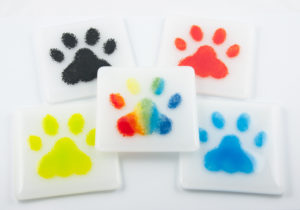About Fusing
What exactly is fusing?
Fusing is the name given to the technique of joining pieces of glass together by heating them until they are partly melted. By varying the maximum temperature and the time spent at that temperature, different degrees of ‘melt’ can be achieved, which enables you to produce either perfectly smooth finished pieces (full fusing) or finished pieces which are joined together but which retain some texture (tack fusing). Fusing temperatures can range between 750-850 degrees Centigrade, depending on the effect you’re trying to achieve, and usually takes place in an electric kiln.

What sort of glass can you use?
Pretty much any type of glass can be used in fusing, although it’s important not to mix different types as incompatibilities can lead to cracking of the finished piece. (It’s all about the difference in coefficient of expansion of different types of glass – I won’t bore you with the details here!) Most of the glass I use is Bullseye glass, which is specifically produced for the glass artist, but I’ve also used empty bottles and old greenhouse glass.

So how do you make a fused glass piece?
The component parts for the finished design are cut out of sheet glass and then assembled/stacked as required, before the piece is fused at the appropriate temperature and then annealed (allowed to cool in a controlled manner to remove any stresses within the glass). Some pieces require more than one fuse, for example if you want to add texture or decorate a full fused piece with special paint. If the finished piece is going to be shaped, such as a bowl, it then requires a further heating in the kiln in order to slump it into a mould.
